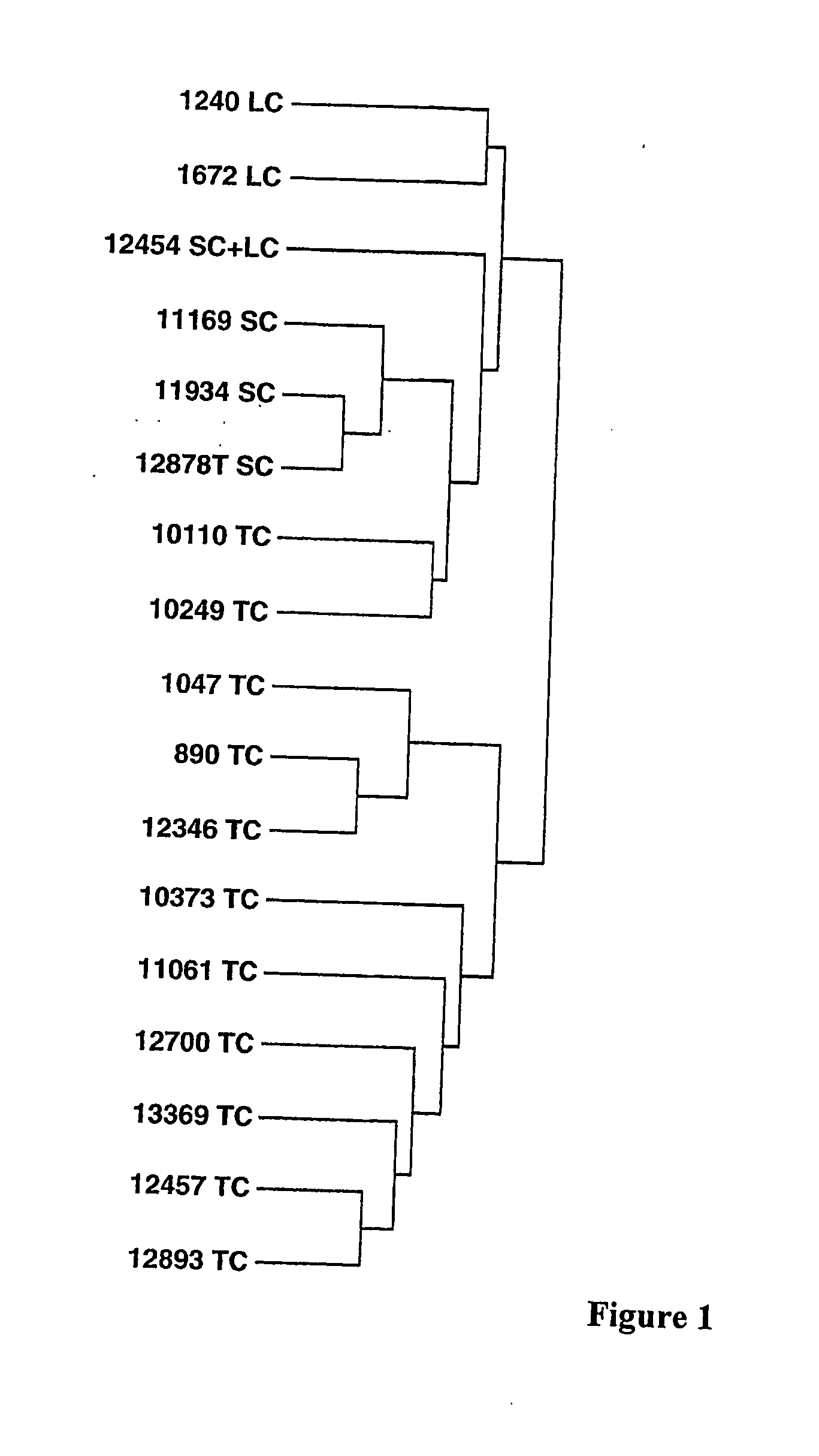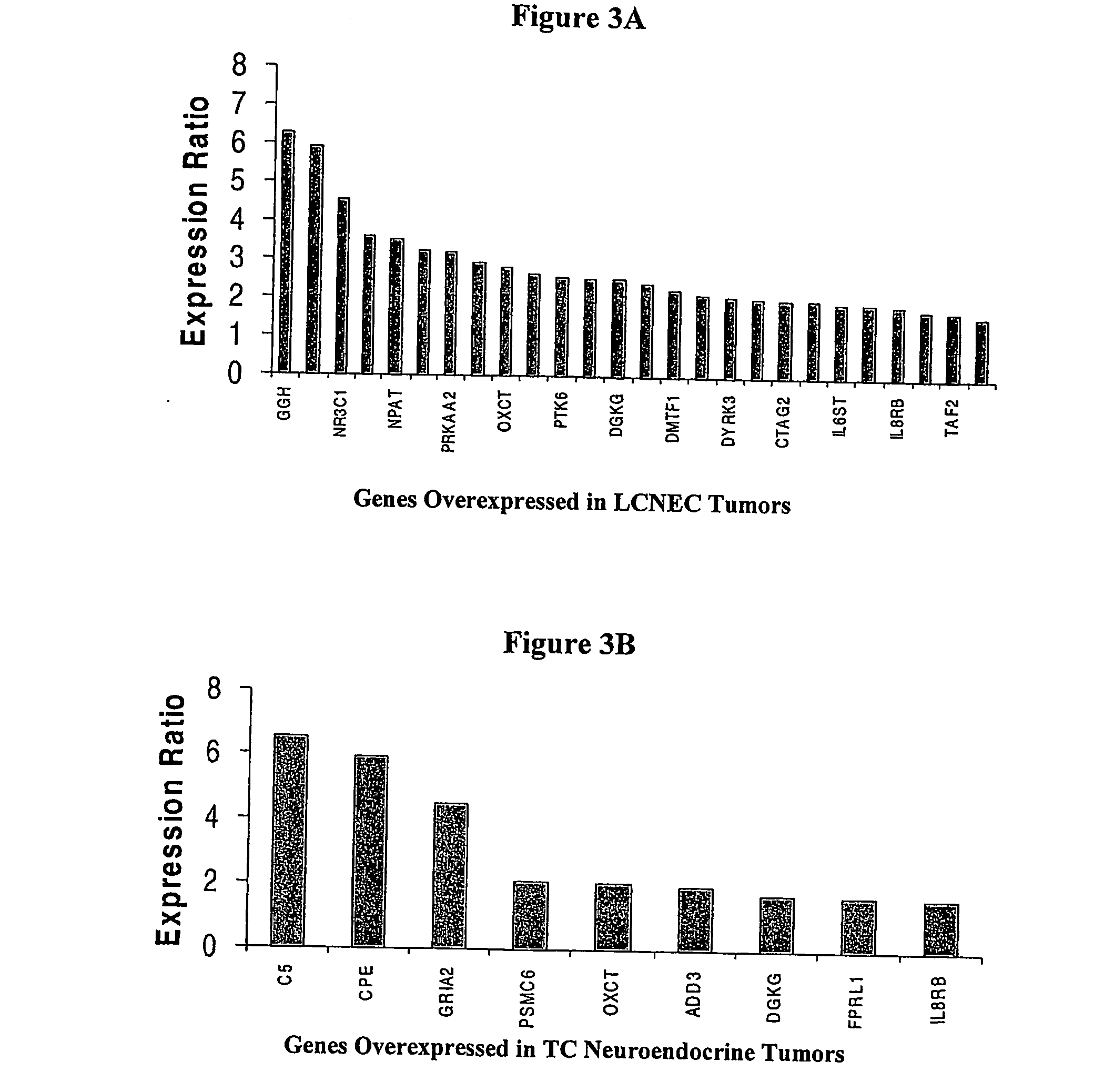Methods and compositions for the diagnosis of neuroendocrine lung cancer
a neuroendocrine and lung cancer technology, applied in the direction of biomass after treatment, organic chemistry, specific use bioreactors/fermenters, etc., can solve the problems of difficult microscopic evaluation of tissue samples, significant difficulty in accurately distinguishing between the different types of neuroendocrine tumors, and the like. to achieve the effect of accurately classifying pulmonary neuroendocrine tumors
- Summary
- Abstract
- Description
- Claims
- Application Information
AI Technical Summary
Benefits of technology
Problems solved by technology
Method used
Image
Examples
example 1
cDNA Microarray
[0061] In order to identify molecular markers of pulmonary neuroendocrine tumors, the gene expression profile of clinical samples from patients with TC, LCNEC, and SCLC is analyzed by cDNA microarrays, preferably as follows:
[0062] Tissue Collection And RNA Quality Assessment. Archived, frozen lung tumor tissues are collected from hospitals over an 11 year period. Tumor tissues are flash-frozen at surgery and stored at −80° C. until used. The frozen tumor tissue block is prepared with O.C.T. mount medium and the quality of total RNA of each sample is evaluated by spectrophotometery and gel electrophoresis after phenol / chloroform extraction from one frozen section. Histopathological classification of these tumors is based on the 1999 WHO Classification (Travis, W. D. et al. (1999) “HISTOLOGIC TYPING OF LUNG AND PLEURAL TUMORS” (Ed 3). Berlin, Germany, Springer). Two large cell neuroendocrine carcinomas (case 1240 and 1672) are confirmed by demonstrating the neuorendoc...
example 2
cDNA Microarray Results
[0069] The results of the microarray analysis are obtained using Laser Capture Microdissection (LCM) as follows:
[0070] Laser Capture Microdissection (LCM) Of Clinical Samples. Use of LCM improves the sample preparation of microarray analysis by avoiding contamination with other cell types. (Emmert-Buck, M. R. et al. (1996) “Laser Capture Microdissection,” Science 274:998-1001). This selection is particularly desirable for analysis of tumors from lung, prostate, overy, and others (Ornstein, D. K. et al. (2000) “PROTEOMIC ANALYSIS OF LASER CAPTURE MICRODISSECTED HUMAN PROSTATE CANCER AND IN VITRO PROSTATE CELL LINES,” Electrophoresis 21(11):2235-2242; Mirura, K. et al. (2002) “LASER CAPTURE MICRODISSECTION AND MICROARRAY EXPRESSION ANALYSIS OF LUNG ADENOCARCINOMA REVEALS TOBACCO SMOKING—AND PROGNOSIS RELATED MOLECULAR PROFILES,”Cancer Res. 62:3244-3250; Ono, K. et al. (2000) “IDENTIFICATION BY cDNA MICROARRAY OF GENES INVOLVED IN OVARIAN CARCINOGENESIS,” Cance...
example 3
Analysis of Gene Expression Profiles
[0079] Analysis of clusters of differentially expressed mRNAs from 9,984 human transcripts assigned to each subtype of neuroendocrine tumors identified multiple genes (198 genes with a probability of 0.004) exhibiting differential expression. This highly selected group of genes contained valuable information which correlated with biological behavior of these tumors. The identified genes are involved in regulation of apoptosis, cell-cell and cell-matrix interactions, cell cycle, DNA synthesis and repair, drug resistance, RNA synthesis and processing, receptors and growth factors. Previous studies using microarray analysis of lymphomas (Dodson, J. M. et al. (2002) “QUANTITATIVE ASSESSMENT OF FILTER-BASED cDNA MICROARRAYS: GENE EXPRESSION PROFILES OF HUMAN T-LYMPHOMA CELL LINES,” Bioinformatics 18:953-960; Ramaswamy, S. et al. (2001) MULTICLASS CANCER DIAGNOSIS USING TUMOR GENE EXPRESSION SIGNATURES,” Proc Natl Acad Sci U S A. 98(26):15149-15154), g...
PUM
| Property | Measurement | Unit |
|---|---|---|
| pH | aaaaa | aaaaa |
| TC | aaaaa | aaaaa |
| electron microscopy | aaaaa | aaaaa |
Abstract
Description
Claims
Application Information
 Login to View More
Login to View More - R&D
- Intellectual Property
- Life Sciences
- Materials
- Tech Scout
- Unparalleled Data Quality
- Higher Quality Content
- 60% Fewer Hallucinations
Browse by: Latest US Patents, China's latest patents, Technical Efficacy Thesaurus, Application Domain, Technology Topic, Popular Technical Reports.
© 2025 PatSnap. All rights reserved.Legal|Privacy policy|Modern Slavery Act Transparency Statement|Sitemap|About US| Contact US: help@patsnap.com



